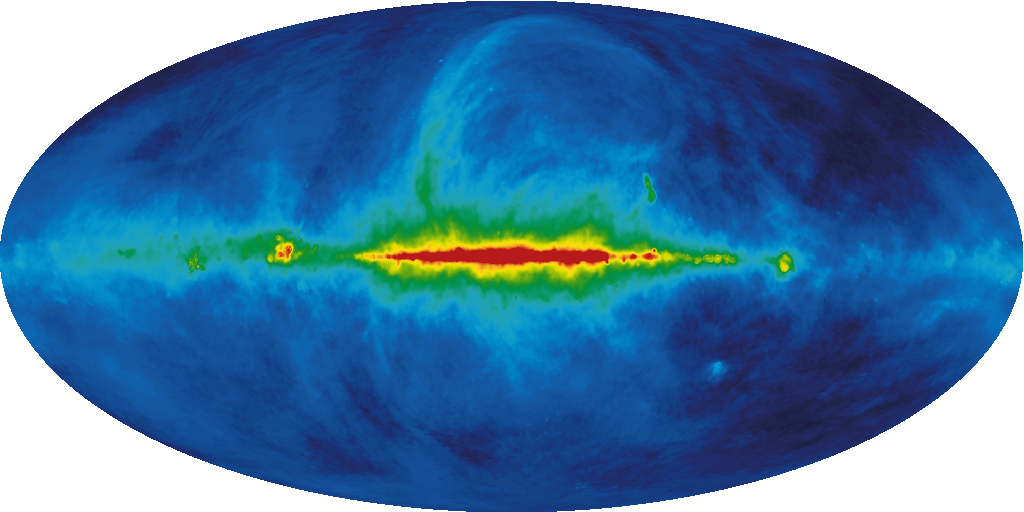SKA Science at the Jodrell Bank Centre for Astrophysics
Some main science areas have been identified as key drivers for the SKA to become a game changing facility that will enable the exploration of unchartered territories of our Universe. Questions that it will tackle includes testing the limits of gravity using pulsars and black holes, investigating the origin and evolution of the cosmic magnetism, and probing how the first stars were formed. In 2014, the scientific community from around the world has been invited to contribute to the making of a science book which purpose is to highlight the groundbreaking science that will be conducted under those science themes. To a large extent, the science presented in this book provides the building blocks shaping up the technical priorities of the SKA.
Astronomers at the Jodrell Bank Centre for Astrophysics played an important role in the writing of the science book. In total, they participated to 45 out of the 135 chapters of the science book, 11 of which were primary authored by JBCA members. You can find below a short description highlighting the JBCA contribution and links to the original papers.
Epoch of Reionization & the Dark Ages
Cosmic Dawn and Epoch of Reionization Foreground Removal with the SKA (Chapman et al.)
The exceptional sensitivity of the SKA will allow observations of the Cosmic Dawn and Epoch of Reionization in unprecedented detail, both spectrally and spatially. This wealth of information is buried under emission due to our own Galaxy and extra-galactic objects, referred to as "foregrounds" because they lie between the observer and the signal. Foregrounds are at least a thousand times brighten than the cosmological signal, therefore they must be removed accurately and precisely in order to reveal it.
An important research topic that is addressed by the Manchester SKA group is the removal of foregrounds in the context of high redshift and high sensitivity 21-cm measurements. Novel, dedicated foreground-removal methods are being developed by exploiting known features of the foreground emission components and the 21-cm signal. State-of-the-art simulations of the SKA observations are used to test the proposed approaches. We compare the recovered cosmological signal using several different statistics and explore one of the most exciting possibilities with the SKA: imaging of the ionized bubbles.
Fundamental Physics with Pulsars
An overview of pulsar science with the SKA (Kramer and Stappers)
Gravitational Wave Astronomy with the SKA (Janssen et al.)
On a time scale of years to decades, gravitational wave (GW) astronomy will become a reality. Low frequency (nanoHz) GWs are detectable through long-term timing observations of the most stable pulsars. Radio observatories worldwide are currently carrying out observing programmes to detect GWs, with data sets being shared through the International Pulsar Timing Array project. One of the most likely sources of low frequency GWs are supermassive black hole binaries (SMBHBs), detectable as a background due to a large number of binaries, or as continuous or burst emission from individual sources. No GW signal has yet been detected, but stringent constraints are already being placed on galaxy evolution models. The SKA will bring this research to fruition.
A Cosmic Census of Radio Pulsars with the SKA (Keane et al.)
The SKA's wide field-of-view, high sensitivity, multi-beaming and sub-arraying capabilities, coupled with advanced pulsar search backends, will result in the discovery of a large population of pulsars. These will enable tests of General Relativity with pulsar binary systems, investigating black hole theorems with pulsar-black hole binaries, and direct detection of gravitational waves in a pulsar timing array. Targeted searches will enable detection of exotic systems, such as the ~1000 pulsars we infer to be closely orbiting Sgr A*, the supermassive black hole in the Galactic Centre.
Three-dimensional Tomography of the Galactic and Extragalactic Magnetoionic Medium with the SKA (Han et al.)
The magneto-ionic structures of the interstellar medium of the Milky Way and the intergalactic medium are still poorly understood, especially at distances larger than a few kiloparsecs from the Sun. SKA will increase the known pulsar population by an order of magnitude and discover pulsars in the most distant regions of our Galaxy. Their observations will enable detailed tomography of the large-scale magneto-ionic structure of both the Galactic disk and the Galactic halo. In addition, extragalactic pulsars or fast radio bursts to be discovered by SKA can be used to probe the electron density distribution and magnetic fields in the intergalactic medium beyond the Milky Way.
Testing Gravity with Pulsars in the SKA Era (Shao et al.)
The SKA will use pulsars to enable precise measurements of strong gravity effects in pulsar systems, which yield tests of gravitational theories that cannot be carried out anywhere else. Dozens of relativistic pulsar systems will be discovered including, possibly, pulsar - black hole binaries, which can be used to test the "cosmic censorship conjecture" and the "no-hair theorem".
Understanding pulsar magnetospheres with the SKA (Karastergiou et al.)
The SKA will discover tens of thousands of pulsars and provide unrivalled sensitivity that will enable us to explore the properties of their magnetospheric radio emission and study eclipsing systems.
Understanding the Neutron Star Population (Tauris et al.)
Since their discovery in the late 1960's the population of known neutron stars (NSs) has grown to ~2500. The surveys that will be performed with SKA will produce a further tenfold increase in the number of Galactic NSs known. The much larger statistical samples will allow us to study the link between the various sub-classes of neutron stars (magnetars, intermittent pulsars, rotating radio transients, etc.). Also, it should provide new insights on their extreme properties such as the maximum masses they can have and the mechanisms leading to their formation in supernovae.
Pulsar Wind Nebulae with SKA (Gelfand, Breton et al.)
Neutron stars lose the bulk of their rotational energy in the form of a pulsar wind: an ultra-relativistic outflow of predominantly electrons and positrons. This pulsar wind significantly impacts the environment and possible binary companion of the neutron star, and studying the resultant pulsar wind nebulae is critical for understanding the formation of neutron stars and millisecond pulsars, the physics of the neutron star magnetosphere, the acceleration of leptons up to PeV energies, and how these particles impact the interstellar medium.
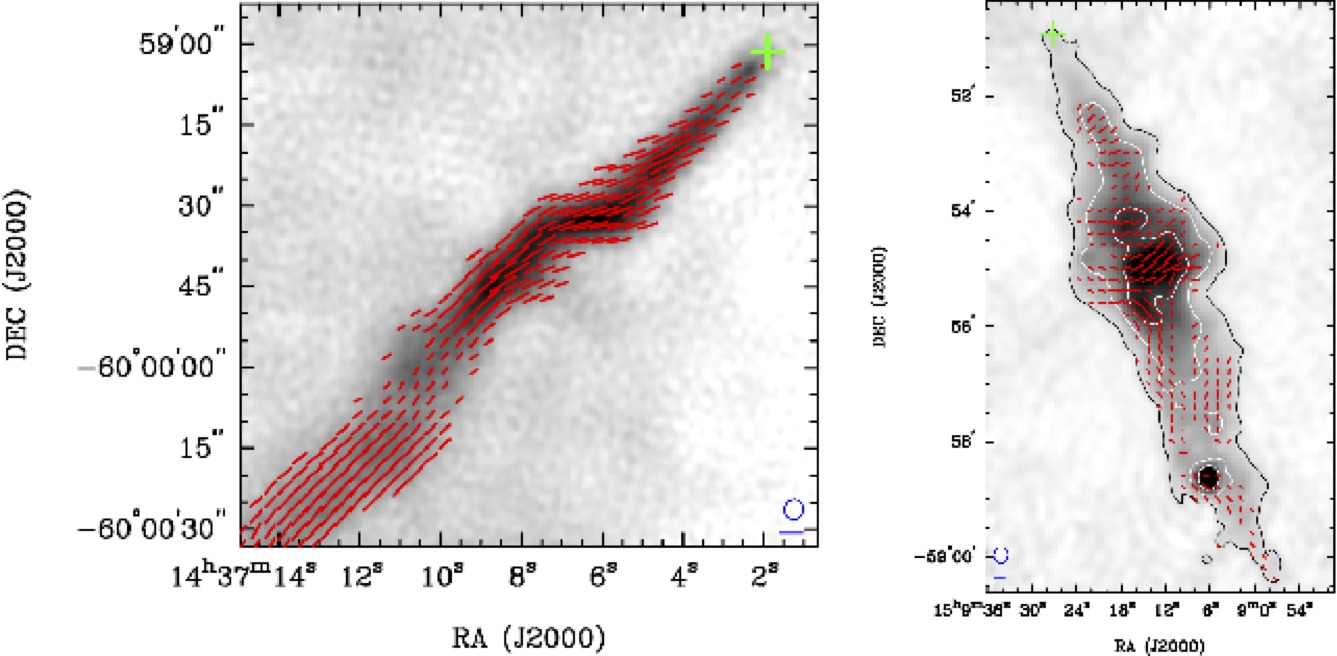
The radio nebulae G315.9-0.0 (left; Ng et al. 2012) and G319.9-0.7 (right; Ng et al. 2010). The location of the associated pulsars are indicated by the green crosses, while the polarization vector is shown by the red lines.
Probing the neutron star interior and the Equation of State of cold dense matter with the SKA (Watts et al.)
With an average density higher than the nuclear density, neutron stars (NS) provide a unique test-ground for nuclear physics, quantum chromodynamics (QCD), and nuclear superfluidity. The most stringent observational constraints on their internal structures come from measurements of NS bulk properties: each model generates a unique mass-radius relation which predicts a characteristic radius for a large range of masses, a maximum mass above which NS collapse to black holes, and a maximum spin frequency. Among other things, the dramatic increase in the number of sources provided by the SKA will provide several new NS mass measurements and allow to probe the highest spin frequency end that they can reach.
Multi-wavelength, Multi-Messenger Pulsar Science in the SKA Era (Antoniadis et al.)
The SKA is an integral part of the next-generation observatories that will survey the Universe across the electromagnetic spectrum. Owing to their extreme nature and clock-like properties, pulsars discovered and monitored by SKA will enable a broad range of scientific endeavour which will benefit from coordinated efforts among SKA and other next-generation astronomical facilities.
Observing Radio Pulsars in the Galactic Centre with the Square Kilometre Array (Eatough et al.)
Timing a pulsar in orbit around a companion, provides a unique way of probing the relativistic dynamics and spacetime of such a system. The strictest tests of gravity, in strong field conditions, are expected to come from a pulsar orbiting a black hole. In this sense, a pulsar in a close orbit (Porb<1 yr) around the supermassive black hole at the centre of the Milky Way would be the ideal tool. Given the size of the orbit and the relativistic effects associated with it, even a slowly spinning pulsar would allow the black hole spacetime to be explored in great detail.
HI and Galaxy Evolution
The Interplay between SF and AGN Activity and its role in Galaxy Evolution (McAlpine et al.)
It has become apparent that active galactic nuclei (AGN) may have a significant impact on the growth and evolution of their host galaxies and vice versa but a detailed understanding of the interplay between these processes remains elusive. Deep radio surveys provide a powerful, obscuration-independent tool for measuring both star formation and AGN activity in high-redshift galaxies. The sensitivity and resolution of the SKA will allow us to gain a detailed picture of the apparently simultaneous development of stellar populations and black holes in the redshift range where both star-formation and AGN activity peak (1<z<4).
Tracing SF over Cosmic Time (Jarvis et al.)
Radio wavelengths offer the unique possibility of tracing the total star-formation rate in galaxies, both obscured and unobscured. As such, they may provide the most robust measurement of the star-formation history of the Universe. We highlight the constraints that the SKA can place on the evolution of the star-formation history of the Universe, the survey area required to overcome sample variance, the spatial resolution requirements, along with the multi-wavelength ancillary data that will play a major role in maximising the scientific promise of the SKA.
The Astrophysics of Star Formation Across Cosmic Time at >10 GHz with the Square Kilometre Array (Murphy et al.)
For studying the detailed astrophysics of star formation at high-redshift, surveys at frequencies >10 GHz have the distinct advantage over traditional ~1.4 GHz surveys as they are able to yield higher angular resolution imaging while probing higher rest frame frequencies of galaxies with increasing redshift, where emission of star-forming galaxies becomes dominated by thermal (free-free) radiation. In doing so, surveys carried out at >10 GHz provide a robust, dust-unbiased measurement of the massive star formation rate by being highly sensitive to the number of ionizing photons that are produced.
Cosmology
Galaxy Cluster Science with the Sunyaev-Zel'dovich Effect (Grainge et al.)
Studying galaxy clusters through their Sunyaev-Zel'dovich (SZ) imprint on the Cosmic Microwave Background has many important advantages. The total SZ signal is an accurate and precise tracer of the total pressure in the intra-cluster medium and of cluster mass, the key observable for using clusters as cosmological probes. Band 5 observations with SKA-MID towards cluster surveys from the next generation of X-ray telescopes such as e-ROSITA and from Euclid will provide the robust mass estimates required to exploit these samples. This will be especially important for high redshift systems, arising from the SZ's unique independence to redshift.
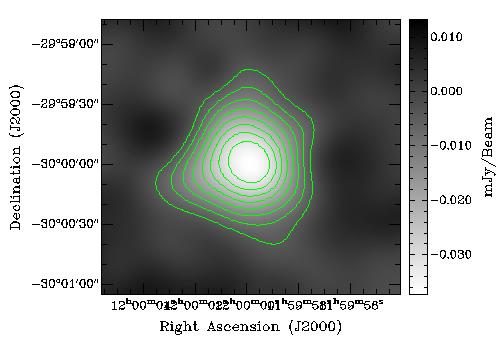
Simulated 1-hour observation with SKA1-MID of a cluster with M200=4x1014 M0 at z=1.83. The cluster SZ effect is detected here at 14σ c.l.
In addition, galaxy clusters are very interesting astrophysical systems in their own right, and the SKA's excellent surface brightness sensitivity down to small angular scales will allow us to explore the detailed gas physics of the intra-cluster medium.
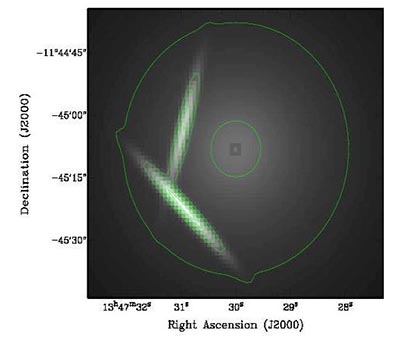
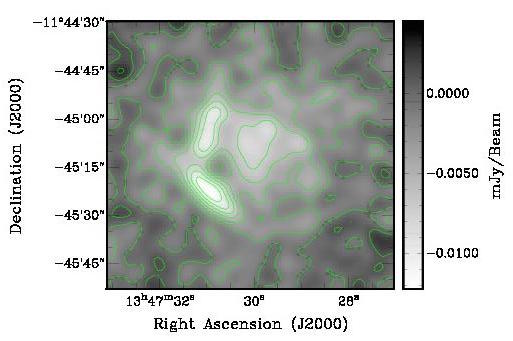
Left: Model of cluster RXJ1347 (z = 0.451) Right: Simulated 1 hour SKA1-MID observation.



